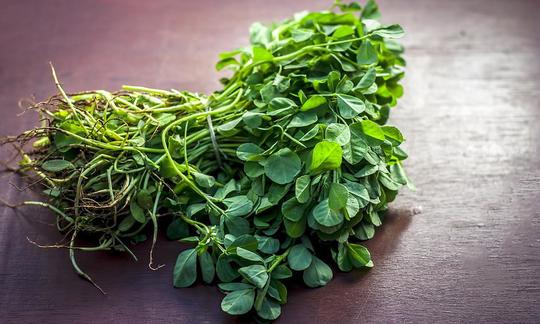Table of contents
Fenugreek leaves ( Trigonella foenum-graecum) or methi leaves are mainly used as a spice, in Asian countries also fresh and raw in a salad or cooked as a vegetable. Make sure they are organic.
Fenugreek leaves - Use in the kitchen:
The aromatic plant has many names, including Greek clover, cow fenugreek, deer woundwort or in Indian methi. What does fenugreek taste like? Fenugreek leaves taste spicy and bitter, have a hint of hay aroma and are reminiscent of lovage. Some connoisseurs say they have an aromatic mix of fennel and celery with a hint of maple syrup.
Raw leaves can be eaten raw and they go well in an aromatic salad or vegan dip (wash well first!). Fresh fenugreek leaves are a great cooked vegetable addition to oriental or Indian dishes.
Used as a spice, it can be used to enhance rice, sauces, curries, lentil or vegetable stews. Dried leaves that have been soaked before use (Kasuri Methi / Kasoori Methi) are much more aromatic than raw ones, so you should use more caution when seasoning than fresh ones.
In the kitchen, fenugreek can be replaced with its relative savory, which has a milder taste. Instead of a large handful of fresh methi leaves, you can also use half a teaspoon of ground fenugreek seeds.
Many curry mixtures contain fenugreek leaves or fenugreek seeds. In South Tyrol, fenugreek seeds are valued as a seasoning for bread and cheese. The germinated seed leaves are also used for cooking or eating raw, similar to garden cress. 1
Fenugreek seeds and leaves are popular ingredients in Indian, Asian, North African, Turkish, Persian and southern European cuisine. In India and the Middle East, dried fenugreek leaves are used to flavor root vegetables 2,3 and in Yemen the plant is a staple food. In modern Egypt, the dried and powdered seeds are used as a substitute for wheat and corn flour. 11 Fenugreek is traditionally used in Indian flatbread (chapati), Turkish dried meat (pastirma) or a Yemeni dip (hilbeh). 1
Vegan recipe for potatoes with fenugreek leaves:
Ingredients: 500 g potatoes, boiling salted water, a bunch of fresh fenugreek leaves (raw, organic), 4-5 tablespoons oil (or less, e.g. rapeseed oil), 1 dried chili pepper (as needed), a small piece of raw ginger, possibly salt and a little lemon juice.
Preparation: Wash and peel the potatoes, cut into large cubes and cook in salted water until al dente. Wash the fenugreek leaves two or three times and drain in a sieve. Heat the oil in a pan and briefly fry the finely chopped chilli pepper with the finely chopped ginger. Then add the steamed, drained potatoes, season with the coarsely chopped fenugreek and fry for a few more minutes at a medium heat. Season with a little salt and/or lemon juice if necessary.
Recipe for (fresh) tea with fenugreek leaves:
You can use fresh or dried fenugreek leaves (Kasoori Methi) to make the tea. 2 You only need 1 teaspoon of the dried greens per cup, as the flavor is very intense. Pour boiling water over the tea and let it brew for about 3 minutes.
In addition to the methi leaves, the seeds of fenugreek are mainly used for tea.
Vegan recipes with fenugreek leaves can be found under the note: " Recipes that have the most of this ingredient ".
| Not only vegans or vegetarians should read this: Vegans often eat unhealthily. Avoidable nutritional errors. |
Shopping - where to buy fenugreek leaves?
Hardly any supermarket such as Coop, Migros, Denner, Volg, Spar, Aldi, Lidl, Rewe, Edeka, Hofer, Alnatura, Denns etc. offers fresh fenugreek. Sometimes you can find the fresh leaves as methi leaves in Asian or Indian grocery stores. You can buy them dried in health food stores, organic stores, pharmacies, drugstores or online. There you can get the leaves as a spice or tea, although the packaging makes no difference for further use.
What is Kasoori Methi? The Indian name for fresh fenugreek leaves is 'Methi'; dried leaves, however, are known as 'Kasoori Methi' or 'Kasuri Methi'. 8 The spicy-bitter herb is also sold commercially under the name Fenugreek leaves or Methi leaves.
Some breastfeeding teas contain fenugreek (seeds), 3 because the ingredients stimulate milk production when consumed regularly. 4 Fenugreek leaves are also sold as functional foods. These are (sometimes enriched) foods that are advertised as having a positive effect on health. 5
Prefer controlled organic quality, as no pesticides may be used in the cultivation of these leaves.
Found in the wild - Season:
Fenugreek grows wild in the eastern Mediterranean region to Central Asia, 4.9 and also in southern and central Germany. It can be found at altitudes of up to 1,000 meters. The plant likes locations with plenty of sunlight and rather loamy soils. Fenugreek tolerates high soil salinity and drought. 11, 18
Trigonella foenum-graecum forms a long taproot with fibrous side roots. The annual plant is herbaceous and reaches heights of around 60 cm. The upright stem is round and only branches at the top, some of the shoots lie on the ground. The leaves are trifoliate and clover-like. The butterfly flowers are found singly or in pairs in the leaf axils and are cream-coloured to yellowish-white. The fruit is a horn-shaped pod up to 10 cm long with 5 to around 20 small, yellowish-brown, dented seeds. All parts of the plant give off a strong smell, especially the crushed seeds.
The flowering period is from May to June 9 (or April to July 7 depending on the location). The seeds ripen from July to September. The fresh, green, three-part leaves are harvested for making tea, as a spice 1 or as a vegetable as required. The season for harvesting the leaves is summer.
Storage:
Fresh fenugreek leaves do not last very long. If you want to eat the methi leaves fresh but not immediately, you can store them in a glass of water in the fridge for a few days. Use only enough water to barely cover the stems. A good way to preserve them is to dry them. If you keep them in an airtight, light-tight container, the dried fenugreek leaves will last for about a year. As with all spices, storing them for longer will damage the aroma.
Ingredients - Nutritional values - Calories:
Fenugreek leaves provide 49 kcal, 1 g fat, 7 g carbohydrates (including 1 g fiber) and 4.4 g protein per 100 g. They are therefore richer in energy and protein than raw spinach, but contain less fiber. 10
According to various studies, fresh methi leaves have a particularly high content of retinol equivalent (RAE) (average amount of 2,104 µg/100g). 11,19-22 RAE is a standardized value for vitamin A and provitamin A, here in the form of carotenoids. High amounts of RAE can also be found in raw vine leaves (1,376 µg/100g), small sorrel (1,250 µg/100g), fresh carrot juice (956 µg/100g) or raw carrots (835 µg/100g). 10
Also worth mentioning is the relatively high vitamin C content in fresh fenugreek leaves. Some studies on fenugreek report vitamin C values of between 52 and 220 mg/100g in the green leaves. 11,19-22 More vitamin C (ascorbic acid) can be found in acerola (1,678 mg/100g), sea buckthorn berries (450 mg/100g), garlic mustard (261 mg/100g) and guava (228 mg/100g).
Boiling, steaming or frying can cause 7-11% of the vitamins in raw fenugreek leaves to be lost. 11 Dryness significantly reduces the chlorophyll content in the leaves. 5
Fenugreek seeds are the most nutritionally valuable part of the plant. 11
The complete ingredients of the fenugreek leaves, the coverage of the daily requirement and comparison values with other ingredients can be found in our nutrient tables in the CLICK FOR under the ingredient picture.
Health aspects - effects:
In a clinical study, scientists analyzed the protective effect of fenugreek leaf extract. As part of the study, animal liver cells poisoned with heavy metals were successfully protected with the plant extract from the leaf green. 12
Another study investigated the effects of aqueous and alcoholic leaf extracts on skin diseases caused by smut fungi ( Malassezia spp.). The results show that a topical gel formulation containing aqueous fenugreek leaf extract can be a safe and effective treatment against various fungal skin infections, including dandruff. 13
Dangers - intolerances - side effects:
Pregnant women should not consume large amounts of fenugreek as it can trigger premature labor. 4 In addition, consuming too large amounts (mainly the seeds) can lead to general gastrointestinal complaints. Side effects of fenugreek (seeds) when used externally repeatedly can include unwanted skin reactions. 14
In 2011, a German organic gardening company imported contaminated fenugreek seeds from Egypt. These seeds were probably the source of the EHEC pathogen that caused the epidemic at the time (with life-threatening intestinal infections). 15 You can read more about this under fenugreek seeds.
Use as a medicinal plant:
The ripe seeds (Trigonellae foenugraeci semen) of fenugreek ( Trigonella foenum-graecum) are used medicinally. HMPC ( Committee on Herbal Medicinal Products), ESCOP ( Association of National European Societies for Phytotherapy) and Commission E ( Expert Committee on Herbal Medicinal Products) describe recognized areas of application for fenugreek seeds. 6,7,9
Folk medicine - natural medicine:
Fenugreek is one of the oldest medicinal plants. Powders and extracts for medicinal purposes are still made from the entire plant, especially the seeds and leaves. Fenugreek is mentioned in the Ebers Papyrus (around 1,500 BC), which is one of the oldest surviving medical documents. 2,11
In ancient Egypt, fenugreek played a role in herbal medicine and obstetrics. 17 On the Indian subcontinent, fenugreek was used to stimulate lactation during breastfeeding and in ancient Rome, it was used during labor and childbirth. 11
Fenugreek can be found in the Lorsch Pharmacopoeia around 800 AD and in the 11th century it appears in Chinese medical texts. Hildegard von Bingen described it as a remedy for skin diseases. From the 13th to the 17th century, the plant and its medical applications were mentioned in many publications. 2,17 The use of fenugreek in folk medicine was revived by Pastor S. Kneipp.
The plant has long been used as a tonic in Chinese and Ayurvedic medicine. In Egypt, the dried plants are now administered as "hilba" for painful menstruation. 2 In Iran, fenugreek leaves are used to treat eye diseases and gynecological disorders. 5
In traditional medicine, fenugreek is used to make infusions, aqueous extracts, tinctures and tonics, as well as preparations (capsules, tablets) that stimulate muscle growth. 5
Occurrence - origin - ecology:
According to genetic studies, fenugreek originated in southeastern Europe and western Asia, i.e. in the Mediterranean region. 16 Remains of fenugreek ( Trigonella) were found in Iraq and can be reliably dated to around 4,000 BC. It was proven to have been cultivated in Assyria in the 7th century BC. 2
Fenugreek reached areas north of the Alps via ancient Greece and the Roman Empire. 17
Today, fenugreek is found in southern Europe, the eastern Mediterranean, the Middle East, India, China, Africa and Australia. 6
Cultivation in the garden or as a potted plant:
Fenugreek is cultivated in rows with a seed spacing of about 20 cm, so that the plants can develop well. 9 The seeds can also be grown as a potted plant in a flowerpot. The heat-loving spice needs a lot of sunlight, warmth and protection from the wind when sowing and growing. Fenugreek prefers fertile, humus-rich, permeable soil. After a growth period of 4 months, the pods with the seeds can be harvested. 1
Cultivation - Harvest:
The medicinal drug comes exclusively from cultures. The main supplier countries are India, Pakistan, Morocco, China, Egypt, Argentina, Turkey and France. 6,7
Most Mediterranean countries grow fenugreek as a spice, as do the countries of the Middle East, the Balkans, Western Asia and China. 2
In southern and central Europe, fenugreek is cultivated as a fodder plant. However, north of the Alps, fenugreek cultivation is very rare. 9 Smaller quantities for breastfeeding teas and other purposes are cultivated in Germany (100 ha) and France (500 ha).
Fenugreek is adapted to different environmental conditions worldwide. It grows in dry and temperate zones as well as in tropical zones. The plant can thrive in areas with 300 to 1,500 mm of annual rainfall and an average annual temperature of 7.8–27.5 °C. Summer conditions with low night temperatures are conducive to plant growth. 11
Ecological impacts:
Although the yield of fenugreek (on sandy soil in arid environment with limited fertilizer input) is low, it is profitable. Since water requirements are low, its cultivation can reduce irrigation and fertilizer costs. In addition, it can limit eutrophication of surface water and reduce subsurface water pollution. 11
Danger of confusion:
Fenugreek can be confused with other types of clover. A close relative is the very similar-tasting savory clover ( Trigonella caerulea). The two plants differ significantly in the shape and color of their flowers. Fenugreek also has a strong smell. 9
Animal protection - species protection - animal welfare:
Bees and bumblebees often visit the flowers of fenugreek. The plant is therefore considered a good bee pasture. Cross-pollination, i.e. by wind or insects, is prevalent. 18
General information:
Fenugreek ( Trigonella foenum-graecum) is one of the 80 species in the genus Trigonella and part of the subfamily Faboideae within the legume family Fabaceae.
The genus name is derived from the Latin 'trigonus' (= triangular, three-edged) and is given the diminutive form ("the small three-edged one"). Linné (1737) used this term to describe the flower, which looks three-edged with its petals, wings and flag. Foenum graecum means "Greek hay". The name probably goes back to the widespread distribution of the plant in the meadows of Greece. 7
The German name "fenugreek" refers to the shape of the fruits, which stand like the "horns of goats" in the calyxes on the stem. 7
Alternative names:
Important alternative names for fenugreek leaves are methi leaves (methi leaves, methi leaves), cow fenugreek, Greek clover and deer antler, methya, methika. Kasoori methi or kasuri methi refers to the dried leaves. Other possible spellings: fenugreek leaves, fenugreek leaves.
Other common names for fenugreek are: Piskavica, Fännezwock, Fine Gret, Grieschheu, Grünschau, Schöne Marie, Schöne Margreth, Siebenzeit, Siebenzeiten, Stundekraut, Zeitkraut, Ziegenhornklee, Gelblicher Schabzigerklee, Fenugräk, Greek hay, Greek hay, Greek fenugreek, rectum, philosopher's clover or horn clover, feine Grete and Filigrazie.
Names such as Rehkörnli, Rehkörner, Siebengezeugsamen, Greek hay seeds, cow horn seeds, cow beans, goat seeds and goat fenugreek seeds refer specifically to the seeds.
In English, fenugreek is called (classical) fenugreek or cultivated trigonella, fenugreek leaves are called fenugreek leaves or methi leaves.
Keywords for use:
The drought-tolerant fenugreek is an important source of food for animals in countries such as Spain or Africa during drought periods.
Fenugreek leaves and seeds are used in the cosmetics industry and in the bodybuilding scene.
Literature - Sources:
Bibliography - 18 Sources (Link to the evidence)
| 1. | Quatmann C. Hausbuch der Kräuter. Der Gute Tip. Stuttgart; 1990. SDK Verlag. |
| 2. | Bown D. Kräuter. Die grosse Enzyklopädie. Anbau und Verwendung. 2. Auflage. München; 2015. Dorling Kindersly. |
| 3. | Deutsche-apotheker-zeitung.de Bockshornkleesamen. |
| 4. | Landeszentrum-bw.de Bockshornklee: Gewürz und Heilmittel zugleich. |
| 5. | Zuk-Golaszewska K, Wierzbowska J. Fenugreek: productivity, nutritional value and uses. Journal of Elementology. 2017;22(3). |
| 6. | Blaschek W. (Herausgeber). Wichtl –Teedrogen und Phytopharmaka. Ein Handbuch für die Praxis. 6. Auflage. Stuttgart; 2016. Wissenschaftliche Verlagsgesellschaft mbH. |
| 7. | Arzneipflanzenlexikon.info Bockshornklee. |
| 8. | Gernot-katzers-spice-pages.com Bockshornklee (Trigonella foenum-graecum L.). |
| 9. | Pahlow M. Das grosse Buch der Heilpflanzen. Gesund durch die Heilkräfte der Natur. 2013. Nikol Verlag. |
| 10. | USDA (United States Department of Agriculture). Nährstofftabellen. |
| 11. | Awais A, Salem SA, Kaiser M et al. Fenugreek a multipurpose crop: Potentialities and improvements. Saudi Journal of Biological Sciences. 2016;23. |
| 12. | Odewumi C, Latinwo LM, Lyles 2nd RL et al. Comparative whole genome transcriptome analysis and fenugreek leaf extract modulation on cadmium-induced toxicity in liver cells. Int J Mol Med. 2018 Aug;42(2): 735-744. |
| 13. | Kulkarni M, Hastak V, Jadhav V, Date AA. Fenugreek Leaf Extract and Its Gel Formulation Show Activity Against Malassezia furfur. Assay Drug Dev Technol. 2020 Jan;18(1): 45-55. |
| 14. | Schilcher H, Kammerer S, Wegener T. Leitfaden Phytotherapie. 3. Auflage. München; 2007. Elsevier GmbH. |
| 15. | Mobil.bfr.bund.de Samen von Bockshornklee mit hoher Wahrscheinlichkeit für EHEC O104:H4 Ausbruch verantwortlich. 022/2011. |
| 16. | Kakani RK, Anwer MM. Fenugreek. Handbook of Herbs and Spices. Vol. I. Woodhead Publishing Series in Food Science, Technology and Nutrition; 2012: 286–298. |
| 17. | Gundolf Keil: Der Bockshornklee als altes Haarwuchsmittel. In: Fachprosaforschung – Grenzüberschreitungen. Band 10, 2014: 37–55. |
| 18. | Bibd.uni-giessen.de Bockshornklee, Griechisch-Heu (Trigonella foenum graecum L. [= Foenum graecum officinale Alef., = F. sativum Medikus, = Telis foenum graecum O. Kuntze]). |








Comments